Disc herniations and protrusions without drugs or surgery
What are the symptoms of a herniated disc.
Symptoms of lumbar disc herniation
- Symptoms pain in the back region of the lumbar disc
- pain in the leg (sciatica, cruralgia) with possible tingling
- loss of strength and lack of tactile sensations
Symptoms of cervical disc herniation
- pain in the neck and shoulders
- headache
- arm pain (brachyalgia) with possible tingling
- loss of strength and lack of tactile sensations
- Dorsal disc herniation
Symptoms of dorsal disc herniation
- Pain in the back region (dorsalgia)
- Pain radiating in the intercostal tract (so-called “belt”) corresponding to the site of the hernia
- Difficulty moving or numbness in the lower limbs.
- Difficulty walking and early fatigue
Schmorl’s hernia
- Schmorl’s hernia is a particular type of disc herniation where the nucleus pulposus of the disc herniates vertically instead of horizontally affecting the vertebral body of the vertebrae above and below.
- They are rarely painful but when they do, they can be very painful.
- They are often associated with symptoms of osteoarthritis, stiffness of movement, and paravertebral muscle stiffening.
- No certain causes are known but, it is hypothesized, that they may be caused by trauma to the spine, microtraumas from postural overload or pathologies that weaken the discs and vertebral bodies.
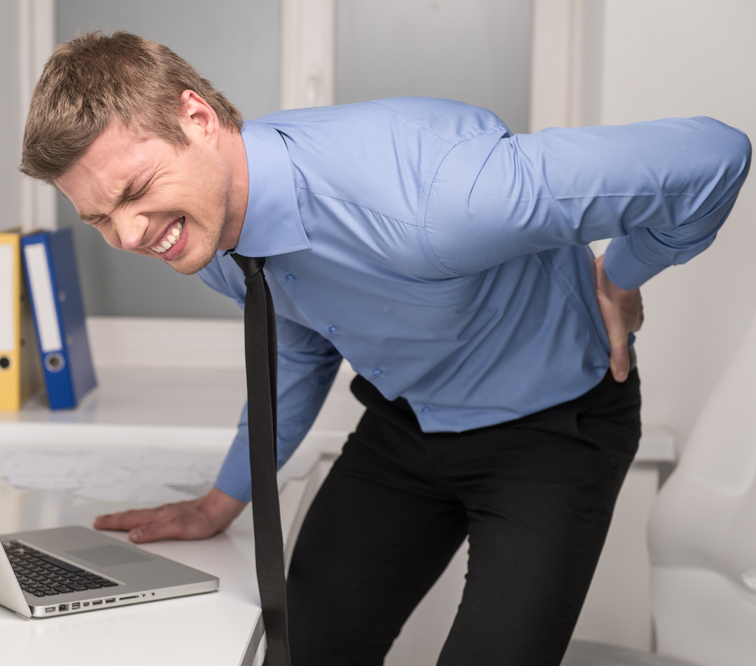
Sciatica
The most common symptom that characterizes cases of disc herniation is severe back pain that radiates down the buttock
and then down the leg to the foot.
This ailment is known as sciatica.
However, depending on the nerves that are irritated, various symptoms may appear following dermatomes in the body, such as cervicobrachialgia, dorsalgia and cruralgia.
The pains are usually very strong and worsen with certain movements, especially bending the back or neck, even the simple act of coughing and sneezing can cause discomfort.
Sometimes the pains are so intense that they prevent sleep for days. In these cases, the drugs normally used to relieve the symptoms are not very effective.
Often the bust twists creating the classic antalgic position that serves to feel less pain.
In the most severe and long-lasting cases, a decrease in muscle strength is noted in the affected limb (objects fall out of the hands, a small bottle cannot be opened or the patient stumbles often), sensory disturbances and wrinkling of the skin due to poor neurovascular microcirculation.
Symptoms can last up to several months and cause a lot of emotional stress, especially when you can’t find an effective and lasting solution over time.
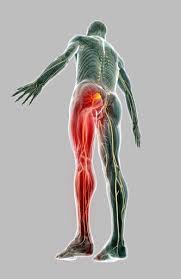
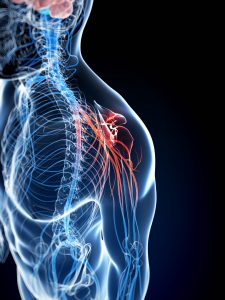
Protrusion or herniated disc? What are the differences
Disc protrusion is characterized by the involvement of only the outer part of the disc, the annulus fibrosus.
Disc herniation, on the other hand, occurs when part of the nucleus pulposus, a gelatinous material inside the disc, escapes from the damaged parts of the annulus fibrosus by entering the spinal canal or intervertebral holes and can irritate neighbouring nerves.
Protrusion and herniated discs can be created in any area of the spine, but the most affected areas are the lumbosacral region and the cervicodorsal hinge.
Depending on the anatomical structures that are irritated, various types of more or less serious disorders and symptoms can occur in different parts of the body.
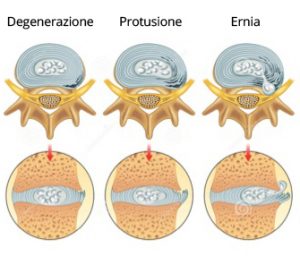
Studio Mazzini: specialists in disc herniation and disc protrusions without drugs or surgery
Herniated discs are one of the most painful and critical causes of back pain.
The World Health Organization and the Istituto Superiore della Sanità recommend to treat this condition with non-surgical procedures.
The staff of Milano Chiropratica is specialized in the treatment of people with even multiple herniated discs and in different parts of the spine with natural methods.
Our specialists constantly check people suffering from symptoms caused by severe herniated discs, on average 80% of those who come to us are affected by these disorders.
It is very common to have several herniated discs and disc protrusions in various areas of the spine.
Sometimes they have already undergone surgery which momentarily seemed to have solved the problem, but which unfortunately came back with a recurring hernia.
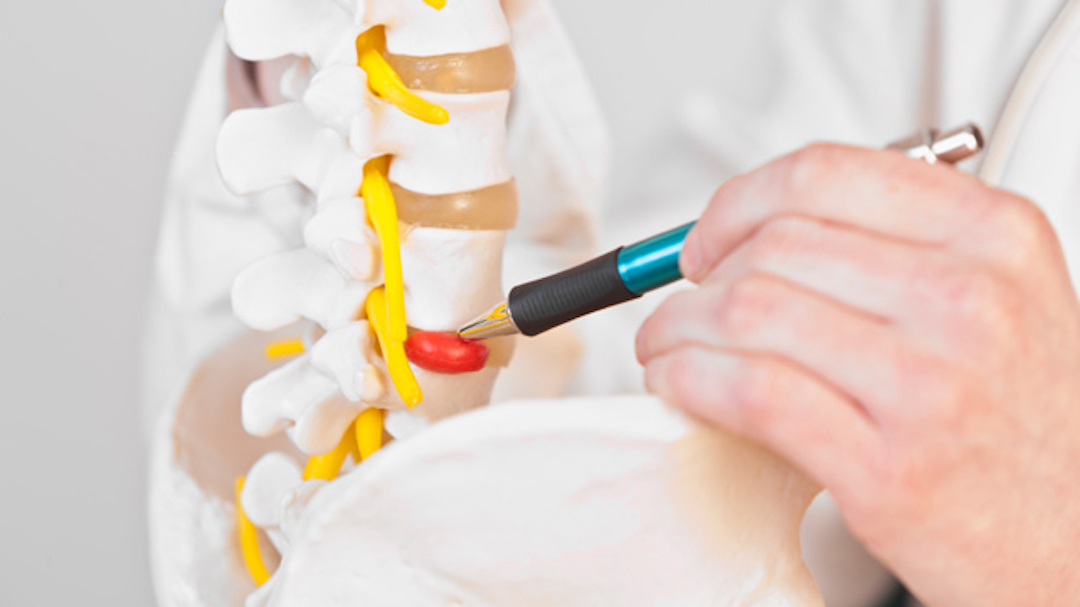
Our experience in the treatment of herniated disc
Many times our center is the almost desperate last resort before facing surgery.
Many times general practitioners and specialists, especially neurosurgeons or orthopedists, do not deem it necessary to operate and suggest our treatments, but most people come to us through the word of mouth of people we have helped.
More and more often the specialists of our firm follow cases that also come from other Italian regions or even from abroad. These people stay in the city for the time necessary to undergo an initial cycle of urgent treatments and then cyclically return to continue the maintenance.
From our experience we know that, if the causes that caused the herniated discs are not eliminated, unfortunately the symptoms can return even stronger than before.
Intervertebral discs have very complex biomechanics that are constantly changing to support the gravitational load and perform a “teamwork”. The weight of the body is distributed among all the discs, so all discs can and do bulge when they are overloaded.
If the overload is prolonged or too heavy, the disc may be damaged.
If the discs are surgically removed, or even partially removed following the most modern surgical techniques, the entire biomechanics of the discs may be damaged and the entire biomechanics of the spine will be affected, leading to premature degeneration of the joints.
For this reason, the World Health Organization and the Higher Institute of Health advise against surgery, preferring non-invasive methods.
Recent scientific research shows that our treatments can be decisive.
Below you can see proof of this.
The images show how the herniated disc between L4 and L5, indicated by the arrow, which had worsened over time without adequate treatment, is completely reabsorbed after receiving the chiropractic treatments of our study.
Before chiropractic treatmants
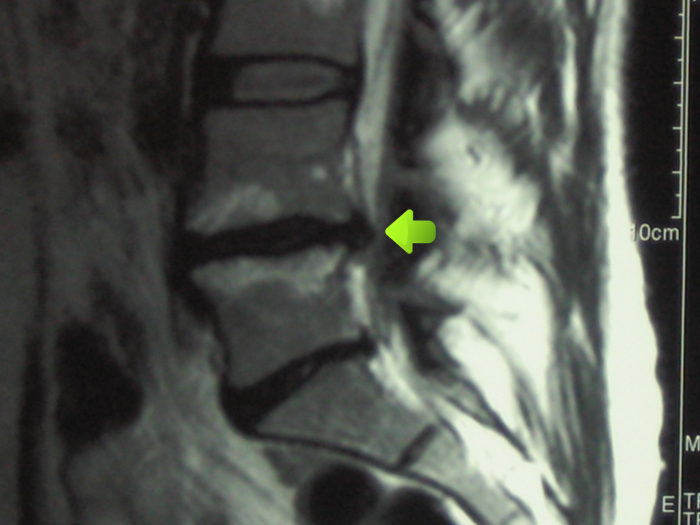
After chiropractic treatments
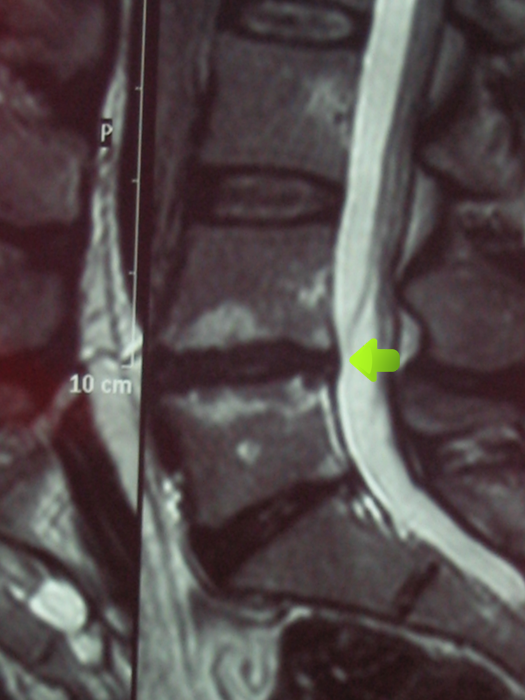
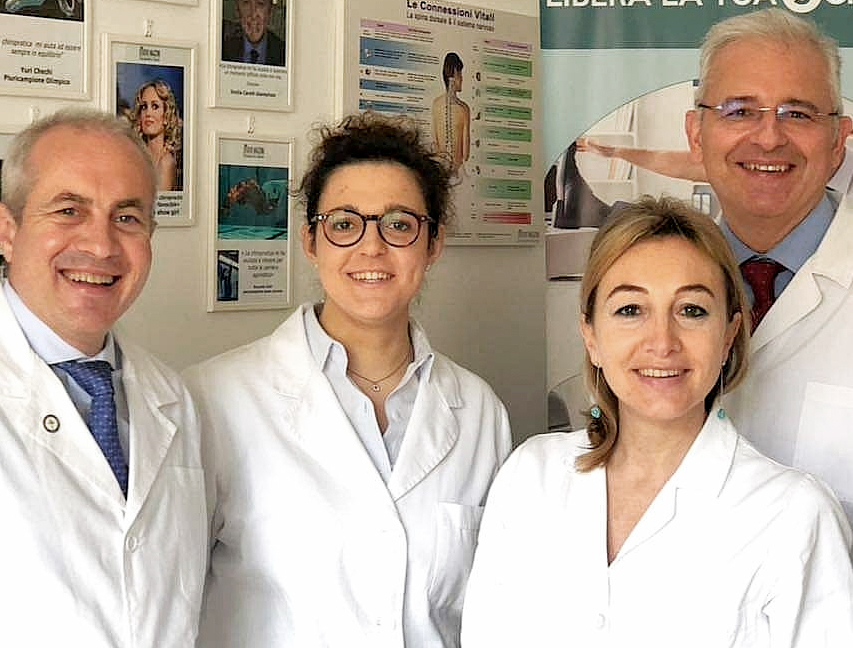
Our method for the treatment of herniated disc
Each case is different and requires a specific, subjective, and targeted treatments. Our intervention is aimed at restoring the functionality of the spine and the nervous system and, therefore, to eliminate the root of the problem, not only to reduce the symptoms.
The first consultation focuses on understanding what the causes of the discomfort may be, how much these symptoms hinder the conduct of a normal life and if it is possible to resolve them naturally, without the use of drugs and surgery.
After a thorough chiropractic check-up with particular attention to posture, neurological functions and balance and mobility, we study the clinical tests (X-rays, CT scans and/or MRIs, electromyography, ultrasounds, blood tests, etc.) and decide which route to take.
The number of sessions, the frequency and the techniques to be adopted are different for each case, even if the path is similar.
A first phase where we focus on helping the person improve as quickly and effectively as possible, a second phase of rehabilitation to allow him to return to complete psychophysical efficiency and a third phase of maintaining the well-being achieved.
Some people respond to treatments faster than others. Some people need to be treated more frequently, even daily, while others may be treated only once a week. In either case, the frequency of treatment tends to decrease to one session per month to maintain balance and well-being.
In the first stage, especially in cases where the person is suffering a lot, it is recommended not to make efforts or exercises after the treatments, in order to give the spine time to settle down, not to overload the intervertebral discs and thus allow it to begin its self-healing process. We have noticed that most of those who suffer from herniated disc disorders are dehydrated, therefore it is recommended that everyone drink at least one and a half liters of plain water a day.
During the second phase of therapy, when symptoms decrease and mobility and neurological functions improve, it is suggested to start moving carefully, taking short walks and learning the “Back School”.
In the third cycle of treatments, when the self-healing process has come to an end, it is recommended to undergo regular monthly chiropractic checks to keep the spine at maximum mobility and the nervous system at maximum function. Prevention is always better than cure.
How long does it take?
The natural path remains long because it is a ligament injury, which therefore requires a few months of rehabilitation to regain its elasticity and functionality.
Usually, a significant improvement in symptoms is noted in the first four weeks of treatment, but it generally takes a few months for the spine to return to its optimal function.
To accelerate the rehabilitation period, it is important to resume physical activity as soon as possible, even if only with short walks and specific exercises of the “Back School” to regain muscle tone.
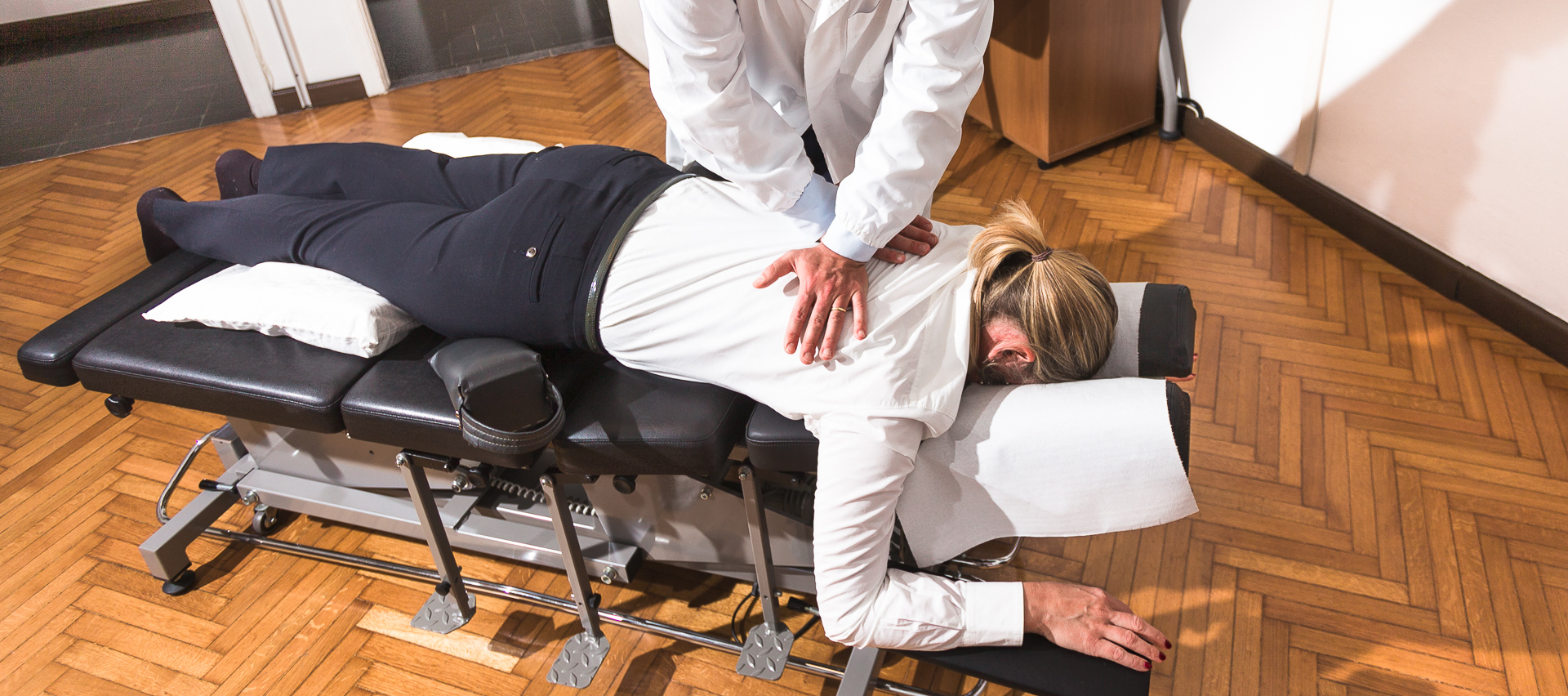
What is a herniated disc?
The adult spine is made up of 33 vertebrae and the intervertebral discs that divide them.
The discs are composed of cartilage and consist of a more resistant external part (anulus fibrosus) and a gelatinous internal part (nucleus pulposus) which cushions the shock of weight and movement. The function of the discs, in addition to cushioning, is to be the pivots on which the vertebrae of the spine move.
The effectiveness of the discs depends on the hydrolytic capacity of their nucleus. The discs are composed of cartilage and consist of a more resistant external part (anulus fibrosus) and a gelatinous internal part (nucleus pulposus) which cushions the shock of weight and movement. To give a simple visual example, a disc that loses water becomes like a rubber that is left in the sun for a long time, loses elasticity, becomes vitrified and therefore becomes more brittle and can easily crumble.
This process also occurs in the intervertebral discs, where a series of biomechanical changes occur that lead to a depolymerization of the protein/polysaccharide bonds in the nucleus pulposus. During this rapid degeneration of polysaccharides, there is a disproportionate loss of chondroitin sulphate to the nucleus pulposus to ketosulfate. Simultaneously, the content of collagen fibres in the annulus fibrosus increases.
This situation leads to a reduction of the hydrolytic and elastic capacities of the nucleus and, consequently, to an increase in the pressure. Consequently, an increase in the pressure transmitted through the annulus fibrosus, which in the long term leads to the cracking of its own fibres, compromising their strength and causing the likelihood of disc protrusions or herniated discs.
Protrusion and herniated discs can be created in any area of the spine, but the most affected areas are the lumbosacral region and the cervicodorsal hinge.
Depending on the anatomical structures that are irritated, various types of more or less serious disorders and symptoms can occur in different parts of the body.
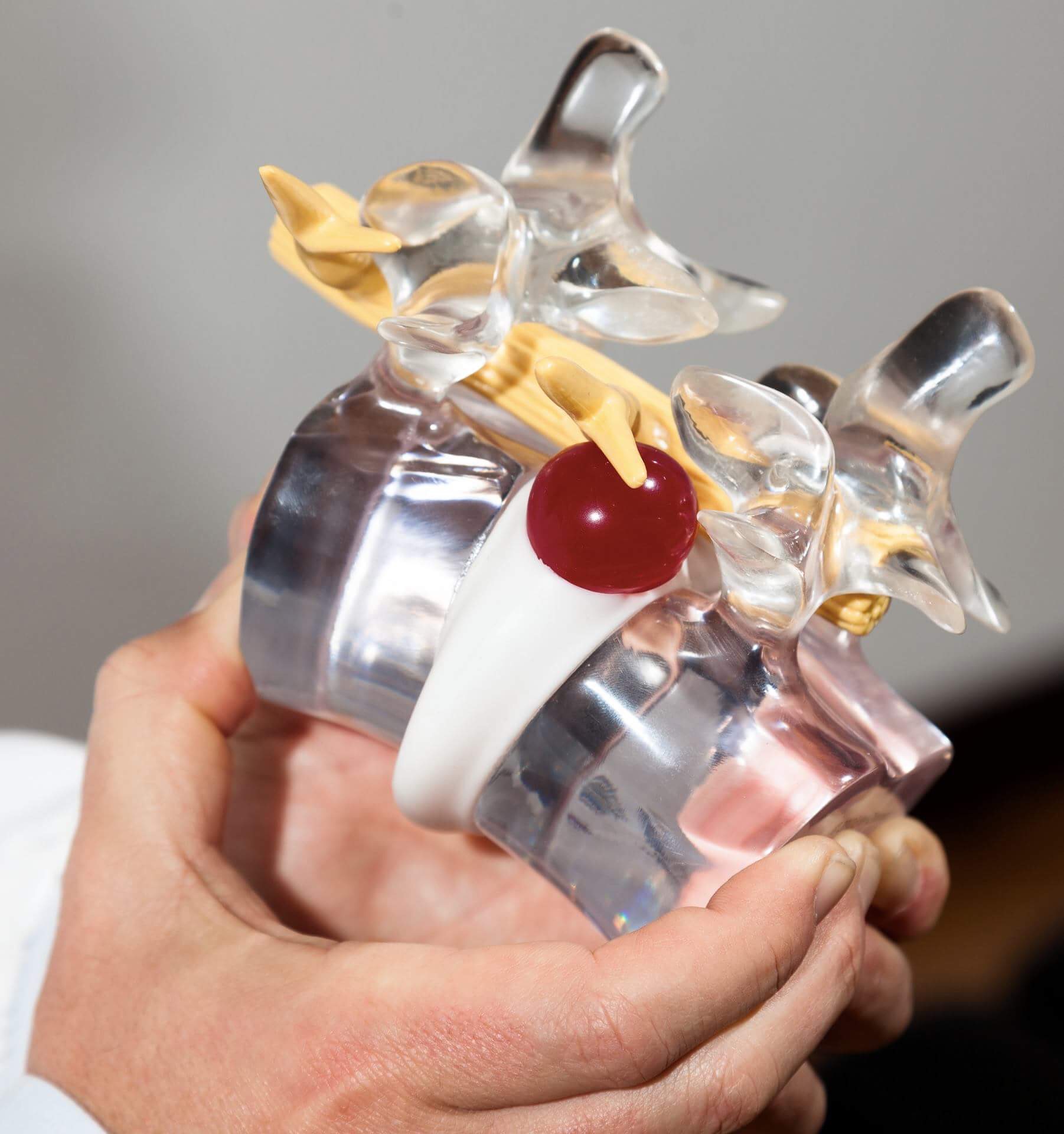
Emotional disc herniation vs physical disc herniation
Disc herniation is a disease that affects thousands of people around the world and in recent years more and more people suffer from it, mainly due to a sedentary and stressful life and bad habits.
The World Health Organization and the Istituto Superiore di Sanità have defined the herniated disc as a pathology to be treated preferably with non-invasive and preferably non-surgical methods.
1) Can a physical pathology be caused by an emotional overload?
Surely! This is demonstrated by many scientific studies that are the basis of psychosomatics.
We at Studio Mazzini find it more and more even in cases suffering from chronic disc herniation. These people are often individuals who have had to endure a prolonged state of stress for a long time and who at some point, without an apparent cause, have started to feel the symptoms of low back pain and sciatica, or neck pain and brachial pain, which they later discover are caused by disc herniation.
We have noticed that these people are often very sensitive and generous human beings, inclined to worry a lot about others, sometimes to the detriment of themselves. The stories they tell us are very similar to each other.
Many have suffered mobbing and work stress, some are in conflict because they are deciding to change their job, others have endured very stressful situations in the family, some helping a sick person at home, some having to deal with a separation or a difficult divorce from the point of emotional view.
In these cases, the herniated disc can be generated in an instant, just a sneeze, a cough, a lifting of even a light weight or a wrong movement even in sleep and excruciating pain immediately begins.
These are typical cases of herniated discs that we define as “emotional” and that need special treatment to heal.
In fact we have noticed that the pharmacological approach alone is not enough to reduce the symptoms and neither is the classic chiropractic approach based on vertebral adjustments and physiotherapy and “back school” exercises that work very well in cases of physical disc herniations.
For this reason we have developed a new specific technique which, in addition to dealing with the postural and biomechanical aspect, focuses on the functional emotional and neurological aspect, the KATMAN technique.
INTERVERTEBRAL DISCS anatomy in brief
The intervertebral discs act as shock absorbers for the spine and allow it to better bear the gravitational weight during every movement of the spine at any time of the day.
They consist of a stiffer central nucleus (nucleus pulposus) and a softer outer ring (anulus fibrosus).
It’s easy to understand how constant overload or physical trauma that changes the curves of the spine can cause a herniated disc. Consider that sitting in a chair increases the gravitational weight that the last lumbar discs have to support by 1|3. In fact, it is no coincidence that the most frequent disc herniations are found between L4/L5 and above all between L5/S1 where 80% of all disc herniations are found.
Office work and sedentary jobs had already created quite a few problems, so much so that “sitting” (sitting for a long time) is considered as dangerous as “smoking” (smoking) was years ago for health in general.
With smart working, these problems have considerably increased and accelerated, because workers often do not have an ergonomically favorable working position at home as in the office. In addition, the increasingly frequent use of tablets and mobile phones brings other serious problems. Often people when using these tools look down instead of looking horizontally. By doing so they tend to flex the neck, increasing postural stress on the cervical region and shoulders, then blocking diaphragmatic breathing.
These poor postural attitudes cause less oxygen to flow to the brain which tires more easily and in the case of children and adolescents it develops more slowly and gets stressed much more easily.
We know that there are various forms of stress such as physical stress, chemical stress and emotional stress. But how is it possible that emotional stress can cause a herniated disc?
Our organism has developed since prehistoric times to be able to withstand only short periods of stress.
When stress becomes chronic, the adrenal glands continue to produce adrenaline and catecholamines including cortisol, hormones that have many negative effects on our body if they are produced constantly.
Too much cortisol prevents the creation of new connections between neurons, causing chronic tiredness and mental fatigue and increases the demand for nutrition to muscles that become increasingly tense and contracted. It also decreases the percentage of water in the joints and intervertebral discs, bringing it to the surface and causing swelling under the skin. As a result, the intervertebral discs, losing water, undergo the process of “vitrification”, stiffen, age prematurely and can more easily be injured, creating disc protrusions or disc hernias.
Often people who suffer from “emotional” hernias have already tried various treatments, including alternatives to the classic pharmacological ones. Sometimes they have even had surgery previously, but the problem has come back.
With the KATMAN technique we have combined the knowledge of the biomechanical and kinesiological chiropractic approach with the new knowledge of functional neurology.
We have thus created a 360° holistic method which aims to bring the neuro-musculoskeletal system into balance, allowing the body to integrate those emotional traumas that have caused the dysfunctions and consequent diseases, making them become experiences.

Bibliography
Kassidy JD, Thiel HW, Kirkaldy-Willis KW. Side posture manipulation for lumbar intervertebral disc herniation. J Manip Physiol Ther 1993;16: 96-103
Nwuga VCB, Relative therapeutic efficacy of vertebral manipulation and conventional treatment in back pain management. Am J Phys Med 1982;6:273278
Bozzao A,Gallucci M, et al. Lumbar disc herniation: MRI imaging assessment of natural history of patients treated without surgery. Neuroradiol 1992;185:13541
Wiesel SW.A study of computer-assisted tomography:the incidence of positive CAT scans in an asymptomatic group of patients. Spine 1984;9:549-51
Chapman-Smith D. La professione Chiropratica 2004.
Vedi libro “La Professione Chiropratica” pagina 118 .4″
Pope MH, Phillips RB, Haugh LD, et al. A prospective randomized three-week trial of spinal manipulation, transcutaneous muscle stimulation, massage and corset in the treatment of subacute low back pain. Spine.
Triano JJ, McGregor M, Hondras MA, et al. Manipulative therapy versus education programs in chronic low back pain. Spine. 1995;20(8):948-955.
Santilli, V, Beghi E, Finucci S (2006) Chiropractic Manipulation in the Treatment of Acute Back Pain and Sciatica with Disc Protrusion: A Randomized Double-blind
Clinical Trial of Active and Simulated Spinal Manipulations, The Spine Journal, in press.
Boos N, Rieder R, Schade V, Spratt KF, Semmer N, Aebi M. 1995 Volvo Award in clinicalsciences. The diagnostic accuracy of magnetic resonance imaging, work perception, and psychosocial factors in identifying symptomatic disc herniations. Spine 1995; 20: 2613-25.


